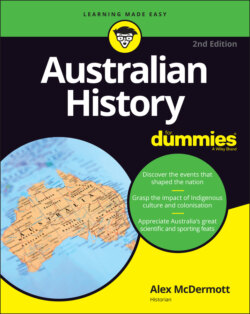Читать книгу Australian History For Dummies - Alex McDermott - Страница 35
SHAPING AUSTRALIA WITH NOMADIC LIFEWAYS
ОглавлениеIndigenous Australians didn’t engage in intensive, settled agriculture. Their lifeways were nomadic rather than sedentary — which is another way of saying they didn’t structure their whole way of life around living in settled villages, nearby fenced-in paddocks and fields. Instead, they moved about relatively frequently, even as they harvested native grasses, constructed elaborate dams and, in some places, stone houses.
As they moved about their country they also practised firestick farming, using fire to manage different environments. This helped create and sustain the enormous grasslands across the plains of south-eastern Australia — and so helped shape and curate the landscape we recognise today as Australian.
In two very direct ways, the lifeways of Aboriginal peoples created the conditions that subsequent Australian society would build with:
The British–European settler society that established itself after 1788 did so in a physical environment that had been crafted, curated and maintained by Indigenous Australians over many millennia. Those who came after benefitted from the tens of thousands years of sustained occupation by this original nomadic society — and they especially benefitted from the fertile grasslands just perfect for sheep and cattle (see Chapter 7).
When the British first came to Australia, they found a low-population density compared to sedentary agricultural societies in other nearby places. In Polynesia and Maori New Zealand, for instance, fortified villages and more intensive cultivation occurred, which meant that when Europeans arrived any violent resistance could draw on more numbers. Australian nomadic society flourished as a small-scale proliferation of small bands, which left them vulnerable to the really huge numbers and resources settler societies could call upon when they arrived in the 18th and 19th centuries.
Violent resistance to European invasion in Australia still occurred, of course. Everywhere the frontier extended, violent conflict took place. But in terms of sheer numbers and scale of response, the dice were stacked against the original possessors of the continent.
